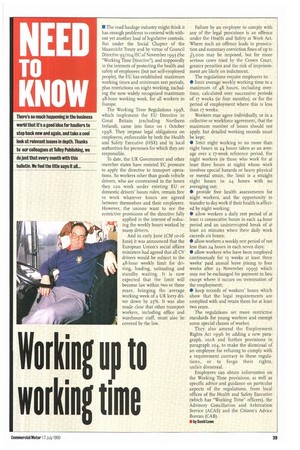There's so much happening in the business world that it's
Page 41

If you've noticed an error in this article please click here to report it so we can fix it.
a good idea for hauliers to step back now and again, and take a coal look at relevant issues in depth. Thanks to our colleagues at Tolley Publishing, we do just that every month with this bulletin. We feel the title says it all... • The road haulage industry might think it has enough problems to contend with without yet another load of legislative controls. But under the Social Chapter of the Maastricht Treaty and by virtue of Council Directive 93,fro4/EC of November 1993 (the "Working Time Directive"), and supposedly in the interests of protecting the health and safety of employees (but not self-employed people), the EU has established maximum working times and minimum rest periods, plus restrictions on night working, including the now widely recognised maximum 48-hour working week, for all workers in Europe.
The Working Time Regulations 1998, which implement the EU Directive in Great Britain (excluding Northern Ireland), came into force on October 1998. They impose legal obligations on employers, enforceable by both the Health and Safety Executive (USE) and by local authorities for premises for which they are responsible.
To date, the UK Government and other member states have resisted EC pressure to apply the directive to transport operations. So workers other than goods vehicle drivers, who are constrained in the hours they can work under existing EU or domestic drivers' hours rules, remain free to work whatever hours are agreed between themselves and their employers. However, the unions want to see the restrictive provisions of the directive fully applied in the interest of reducing the weekly hours worked by many drivers.
And in early June (CM ro-i6 June) it was announced that the European Union's social affairs ministers had agreed that all CV drivers would be subject to the 48-hour weekly limit for driving, loading, unloading and standby waiting. It is now expected that the limit will become law within two or three years, bringing the average working week of a UK lorry driver down by 25%. It was also made clear that other transport workers, including office and warehouse staff, must also be covered by the law.
Failure by an employer to comply with any of the legal provisions is an offence under the Health and Safety at Work Act. Where such an offence leads to prosecution and summary conviction fines of up to £5,000 may be imposed, but for more serious cases tried by the Crown Court, greater penalties and the risk of imprisonment are likely on indictment.
The regulations require employers to: • limit average weekly working time to a maximum of 48 hours, including overtime, calculated over successive periods of 17 weeks (ie four months), or for the period of employment where this is less than 17 weeks.
Workers may agree individually, or in a collective or workforce agreement, that the maximum number of hours should not apply, but detailed working records must be kept; • limit night working to no more than eight hours in 24 hours taken as an average over a 17-week reference period. For night workers (ie those who work for at least three hours at night) whose work involves special hazards or heavy physical or mental strain, the limit is a straight eight hours in 24 hours with no averaging out; • provide free health assessments for night workers, and the opportunity to transfer to day work if their health is affected by night working;
• allow workers a daily rest period of at least II consecutive hours in each 24-hour period and an uninterrupted break of at least an minutes when their daily work exceeds six hours;
• allow workers a weekly rest period of not less than 24 hours in each seven days; • allow workers who have been employed continuously for 13 weeks at least three weeks' paid annual leave (rising to four weeks after 23 November 1999) which may not be exchanged for payment in lieu except where it occurs on termination of the employment; • keep records of workers' hours which show that the legal requirements are complied with and retain them for at least two years.
The regulations set more restrictive standards for young workers and exempt some special classes of worker.
They also amend the Employment Rights Act 1996 by adding a new paragraph, ioiA and further provisions in paragraph 104, to make the dismissal of an employee for refusing to comply with a requirement contrary to these regulations, or to forgo their rights, unfair dismissal.
Employees can obtain information on the Working Time provisions, as well as specific advice and guidance on particular aspects of the regulations, from local offices of the Health and Safety Executive (which has "Working Time" officers), the Advisory Conciliation and Arbitration Service (ACAS) and the Citizen's Advice Bureau (CAB).
II by David Lowe
















































































































